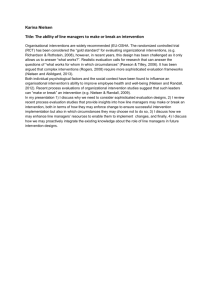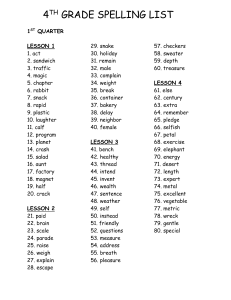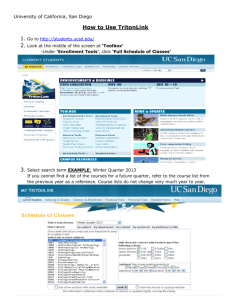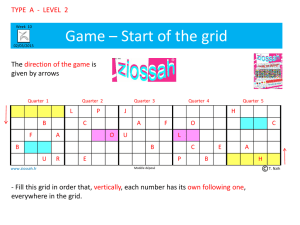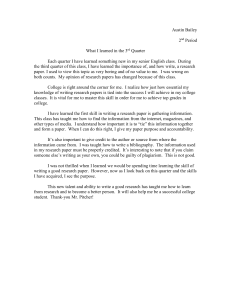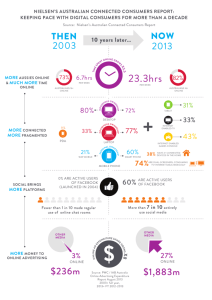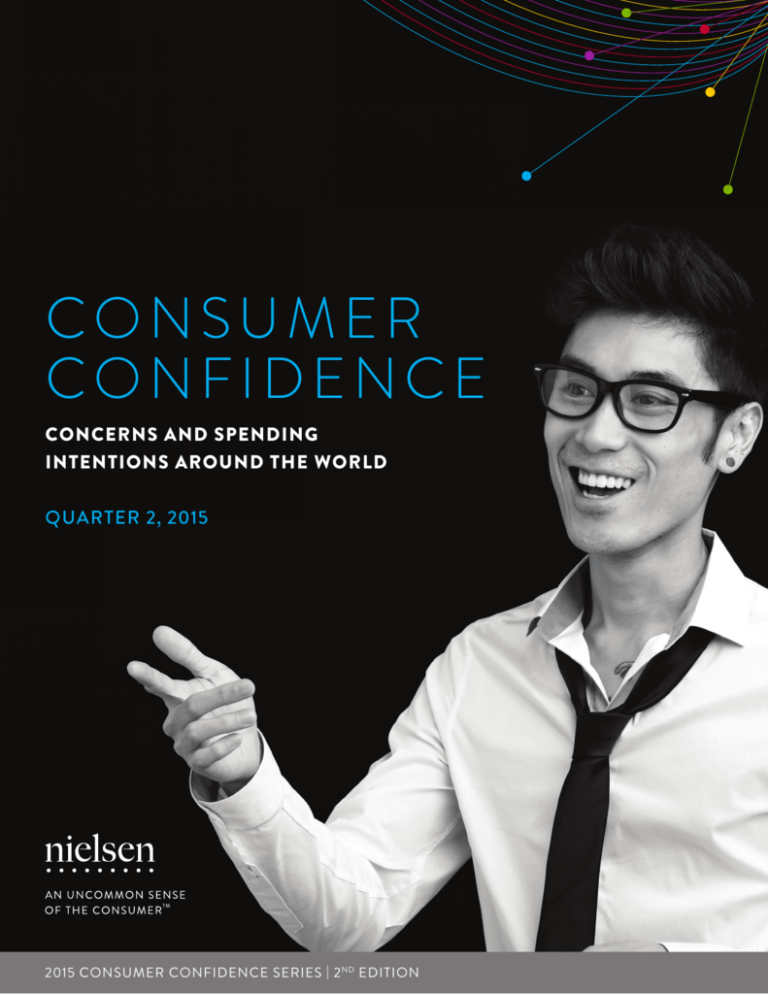
CONSUMER
CONFIDENCE
CONCERNS AND SPENDING
INTENTIONS AROUND THE WORLD
QUARTER 2, 2015
2015 CONSUMER CONFIDENCE SERIES | 2 ND EDITION
CONSUMER
CONFIDENCE
IMPROVED IN
EUROPE IN THE
SECOND QUARTER,
WHILE IT DECLINED
OR REMAINED FLAT
IN OTHER REGIONS
•
Confidence rose in Europe to an index score of 79—its highest
level in five years.
•
North American confidence remained optimistic at 101 but
declined five points from the first quarter.
•
Asia-Pacific confidence held steady at 107, the highest level of all
regions.
•
Latin American confidence continued to decline, dropping three
points to 83—the lowest level since 2009.
•
Middle East/Africa confidence declined two points to 94, as
spending and personal finance sentiment dropped.
•
Recessionary sentiment improved in 78% of European markets
measured but worsened throughout all other regions.
Global consumer confidence declined one index point in the second
quarter to a score of 96, as overall sentiment about job prospects and
personal finances dropped two and one percentage point(s), respectively
from the first quarter. This near-baseline score, which has stayed
relatively consistent for more than a year, reflects an overall stable
outlook, but uneven performance at the country level increased within
regions—especially in Latin America and the Middle East.
2
QUARTER 2 2015 - GLOBAL CONSUMER CONFIDENCE REPORT
Regionally, confidence continued to rise in Europe, increasing two points to
79—its highest score since 2010, as 65% of markets showed improvement
from the first quarter. In Asia-Pacific, confidence held steady at 107, and it
declined five points in North America (101), two points in the Middle East/
Africa (94) and three points in Latin America (83).
ABOUT THE GLOBAL
SURVEY METHODOLOGY
The findings in this survey are
Among the world’s largest economies, confidence remained at near- and
above-the-baseline levels in Germany (97) and the U.S. (101) despite
quarterly index declines of three and six points, respectively. In China (107)
and the U.K. (99), consumer confidence increased one and two points,
respectively, and it increased one point in Japan (83) from the first quarter.
based on respondents with
“Contrasts within and across markets continue to be a dominant feature
of the global economy,” said Louise Keely, senior vice president, Nielsen,
and president, The Demand Institute. “Consumer confidence in Eurozone
markets has been relatively stable, with the notable exception of Greece. While quantitative easing is largely viewed as doing as intended, Europe
is now moving through the Greek debt crisis. A relatively strong starting
point for confidence will support consumer spending as the crisis unfolds.
In China, slowing GDP growth sits alongside a stock market that has been
soaring. Confidence has not faltered there either, which bodes well for
consumer spending in the near term. Meanwhile, Brazil, with its unusual
combination of recession and inflation, saw consumer confidence decline
to a record low level this quarter. We expect the situation there to continue
to impact spending behavior.”
and global reach, it provides a
In the latest online survey, conducted May 11-29, 2015, consumer
confidence increased in 27 of 60 markets measured by Nielsen (45%).
India’s score of 131 was the highest level among 60 markets, followed by
the Philippines (122), Indonesia (120) and Denmark (112). The Philippines
showed the biggest quarterly improvement, as confidence there rose seven
points, and Greece showed the biggest quarterly decline of 12 points from
the first quarter. South Korea reported the lowest score of 45.
online access in 60 countries
(unless otherwise noted). While
an online survey methodology
allows for tremendous scale
perspective only on the habits
of existing Internet users, not
total populations. In developing
markets where online penetration
is still growing, audiences may
be younger and more affluent
than the general population of
that country. In addition, survey
responses are based on claimed
behavior rather than actual
metered data. The Nielsen consumer confidence index measures perceptions of local
job prospects, personal finances and immediate spending intentions.
Consumer confidence levels above and below a baseline of 100 indicate
degrees of optimism and pessimism, respectively. The Nielsen Global
Survey of Consumer Confidence and Spending Intentions, established
in 2005, measures consumer confidence, major concerns and spending
intentions among more than 30,000 respondents with Internet access in
60 countries.
Copyright © 2015 The Nielsen Company
3
GLOBAL CONSUMER CONFIDENCE
GLOBAL CONSUMER CONFIDENCE
SURVEY – 60 Countries – 3-Month Trend
60 COUNTRIES – 3-MONTH TREND
Q2-2015 Nielsen ConsumerQ2-2015
Confidence
Index
NIELSEN
CONSUMER CONFIDENCE INDEX
+7
0
-12
IND
+1
-1
+7
EX
-3
ES
AB
+6
57
+5
+1
+2
+6
GLOBAL
AVERAGE
UM
N
HU
JA
-7
LIT
+6
-1
+4
+1
NORTH AMERICA
-1
-3
-4
-2
LATIN AMERICA
-5
+3
0
EUROPE
+1
-8
NG
O
UD
7
SA NG K
10 5
O
H
AM
10
TN
5
10
VIE
N
ISTA
104
PAK
ES
STAT
102
NITED
U
101
ND
W ZEALA
99 NE
99 SINGAPORE
0
-6
-3
-1
99 UNITED KINGDOM
+2
98 CA
NADA
98
SWIT
+2
97
ZERL
AND
GER
95
MA
NY
PE
93
+4
RU
92
CO
90
LO
IS
M
R
-3
N AEL BIA
ET
H
ER
-4
LA
N
D
-1
S
( -1 change from Q1-2015 )
PA
BE
L
GI
-1
-1
IA
AB
R
IA
A
LI
RA
ST
SIA
AU LAY
D
A
N
M
A
89
L
IRE WAY
89
IC
R
UBL
88
NO
REP
CH
88
CZE
EN
88
SWED
88
KEY
87 TUR
SOUTH AFRICA
87
+4
-2
COUN
96
83
AN
I
83
CH A
ILE
83
TAIW
84
AN
84
MEXI
CO
84
EGYPT
85
AUSTRIA
85
-3
INDEX
T
EN
ID
LES
S
+3
MO
RE
CO
N
NT
DE
FI
IA 59
ZU
61
ELA
FRA
NCE 62
66
FINL
AND
66
POL AND
70
SPAIN 72
BULGARIA 73
IA 75
SLOVAK
78
IA
S
RUS
78
A
79
ANI
M
RO
A
I
81
V
T
LA ZIL
81
A
82
BR INA
T
A
I
N
GE ON
T
AR
S
E
NE
TRY
131
INDI
A
122
120 PHILIP
PIN
IND
ES
112
111
DE ONES
N
IA
10
MA
TH
8
RK
UN AILA
N
IT
ED D
AR
AB
EM
IR
AT
ES
TIA
CO
NF
EN
A
IN
CH
M
OV
AL
+1
IS
SL
VE
OA
UG
A
IM
+6
RT
CR
IC
PT
-3
D
O
PO
UN
H
+4
IN
TE
+1
00
-7
A 45
ORE
48
TH K
SOU
NE
I
A
53
UKR
BIA
53
SER
53
CE
EE Y
55
L
GR
ITA RY
GA
-2
E1
-3
-4
-2
OV
+1
+5
+3
+4
+1
-6
-5
-4
AFRICA, MIDDLE EAST
ASIA-PACIFIC
Index levels above and below 100 indicate degrees of optimism/pessimism.
*Survey is based on respondents with Internet access. China survey results reflect a mixed methodology. Index levels above and below 100 indicate degrees of optimism/pessimism.
4
QUARTER 2 2015 - GLOBAL CONSUMER CONFIDENCE REPORT
CONSUMER
CONFIDENCE IS
LINKED TO RETAIL
ACTIONS
Consumer assessments of their economy and their own financial situations
can have a direct impact on their willingness to spend and their proclivities
to save. As such, there is a relationship between changes in consumer
confidence and the actions consumers say they take to save on household
expenses. “Even as sentiment about consumers’ own personal situations has risen in
recent years, there is still a widespread concern among consumers about
recession,” said Keely. “In fact, six years after the official end of the Great
Recession, more than half (54%) of global respondents still believe their
country is in recession. So while global consumer confidence has been
rising slowly to reach near optimistic levels in the past year, there is still
evidence that consumers feel uncertain about their countries’ futures.
Retail sales activity has been slower to respond, reflecting that lingering
uncertainty.”
Anemic consumer spending levels are reflective of the fact that nearly twothirds (65%) of consumers around the world are in a saving—rather than
a spending—mindset. This cautionary outlook is most prevalent in Latin
America (79%), followed by Middle East/Africa (69%), Asia-Pacific (66%),
North America (59%) and Europe (58%), as more than half of respondents
in these regions say they are actively taking action to save on household
expenses compared to a year ago.
Priorities on saving strategies differ across regions.
Among those who say they are taking actions to save, the top two areas
earmarked for reduction are spending on clothing and out-of-home
entertainment costs. Cutting back on gas and electricity costs, along with
spending less on take-out meals and switching to cheaper grocery brands
are other top saving priorities. Somewhat more protected are expenses that
affect transportation, annual holidays/vacations, at-home entertainment
and the replacement of major household appliances.
Copyright © 2015 The Nielsen Company
5
TOP 5 SAVING STRATEGIES BY REGION
COMPARED TO THIS TIME LAST YEAR, WHICH OF THE FOLLOWING ACTIONS
HAVE YOU TAKEN IN ORDER TO SAVE ON HOUSEHOLD EXPENSES?
SPEND LESS
ON NEW
CLOTHES
CUT DOWN ON
OUT-OF-HOME
ENTERTAINMENT
SAVE ON
GAS AND
ELECTRICIT Y
ASIA-PACIFIC
SWITCH TO
CHEAPER
GROCERY
BRANDS
CUT DOWN ON
TAKE-AWAY
MEALS
EUROPE
57%
46%
52%
41%
38%
43%
27%
50%
31%
38%
MIDDLE EAST/AFRICA
LATIN AMERICA
49%
49%
41%
51%
48%
40%
44%
28%
48%
32%
NORTH AMERICA
53%
48%
50%
46%
46%
Source: Nielsen Global Survey of Consumer Confidence & Spending Intentions, Q2 2015
6
QUARTER 2 2015 - GLOBAL CONSUMER CONFIDENCE REPORT
CONCERNS
WEIGHING MOST
HEAVILY ON
CONSUMERS DIFFER
AROUND THE
WORLD
Certain concerns are universal. Worries about the state of the economy,
fear of losing a job or anxieties about health issues are top concerns in
all regions of the world. But other concerns take on greater significance
depending on where you live. Understanding the emotional burdens that
weigh heavily on consumers provide insight into the factors that can
drive behavior.
For example, debt and increasing food prices are top concerns among
North Americans. Crime and work/life balance top the list of anxieties
in Latin America. Parents’ welfare and happiness is a key issue for those
in Asia-Pacific and Middle East/Africa, and rising utility bills is a major
worry for Europeans.
Copyright © 2015 The Nielsen Company
7
“Demand-driven growth strategies of consumer-facing businesses are
vital for connecting the right products and right communication with the
right consumers,” said Keely. “Strategies should be developed with an
understanding of what consumers’ concerns and worries are, which can
inform both unmet needs and product innovation opportunities, as well
as directions for better messaging to consumers.”
Levels of concern vary by country, and the relative significance of each
illustrates the myriad of worries that affect consumers in the global
landscape.
BIGGEST AND SECOND BIGGEST CONCERN IN THE NEXT SIX MONTHS
Countries with the highest level for each concern
Q2 2015
Colombia
42%
United Arab Emirates
50%
Ukraine
56%
Israel
9%
THE ECONOMY
Venezuela
46%
Turkey
56%
HEALTH
Lithuania
42%
Romania
28%
WORK/LIFE BALANCE
Portugal
38%
Indonesia
33%
CRIME
Venezuela
37%
Argentina
35%
INCREASING FOOD PRICE
Venezuela
33%
France
29%
CHILDREN’S EDUCATION AND
WELFARE
Lithuania
31%
Hungary
24%
DEBT
Greece
30%
Romania
29%
INCREASING UTILITY BILLS
Ireland
27%
Poland
37%
United Arab
Emirates
24%
Indonesia
25%
TERRORISM
France
22%
Pakistan
18%
POLITICAL STABILITY
Turkey
22%
Venezuela
24%
GLOBAL WARMING
India
19%
Norway
11%
Vietnam
18%
U.S.
11%
U.K.
16%
U.K.
10%
JOB SECURITY
WAR
PARENTS’ WELFARE AND
HAPPINESS
INCREASING FUEL PRICES
IMMIGRATION
8
2009
QUARTER 2 2015 - GLOBAL CONSUMER CONFIDENCE REPORT
NOT ALL CONCERNS ARE EQUAL AROUND THE WORLD
BIGGEST AND SECOND BIGGEST CONCERNS IN THE NEXT SIX MONTHS
EUROPE
ASIA-PACIFIC
29%
ECONOMY
JOB SECURITY
22%
HEALTH
27%
ECONOMY
20%
WORK/LIFE
BALANCE
26%
HEALTH
19%
INCREASING
UTILITY BILLS
22%
JOB SECURITY
MIDDLE EAST/AFRICA
ECONOMY
PARENTS’ WELFARE &
HAPPINESS
TERRORISM
LATIN AMERICA
29%
JOB SECURITY
17%
31%
ECONOMY
19%
JOB SECURITY
17%
15%
25%
CRIME
22%
HEALTH
21%
NORTH AMERICA
28%
ECONOMY
DEBT
INCREASING
FOOD PRICES
HEALTH & JOB SECURITY
22%
17%
15%
= CONCERN IS SIGNIFICANTLY
HIGHER THAN IN OTHER REGIONS.
Source: Nielsen Global Survey of Consumer Confidence & Spending Intentions, Q2 2015
Copyright © 2015 The Nielsen Company
9
THE FUTURE IS
LOOKING BRIGHTER
THROUGHOUT
EUROPE
While recessionary sentiment lingers for more than half of global
respondents (54%), levels improved in 31 of 60 countries from the first
quarter. The biggest improvements came from European countries, with
Russia’s recessionary sentiment dropping 16 percentage points to 65%.
While recessionary sentiment levels are still high throughout Europe,
significant quarterly improvements are evident in Austria, Belgium,
Romania, U.K., Israel and Slovenia.
The same is not true in Latin America, where recessionary sentiment is high
in Venezuela (94%), Brazil (90%) and Mexico (82%), and it continues to
grow in Peru, Chile and Colombia.
Recessionary sentiment also grew in the U.S. (57%), India (50%) and New
Zealand (35%) by seven, six and five percentage points, respectively, from
the first quarter.
RECESSIONARY SENTIMENT IMPROVES IN EUROPE AND
WORSENS IN L ATIN AMERICA
BIGGEST RECESSIONARY
IMPROVEMENT
Q1
2015
10
Q2
2015
GROWING RECESSIONARY
SENTIMENT
Q1
2015
Change
Q2
2015
Change
Russia
81%
65%
-16%
Peru
46%
56%
10%
Austria
69%
61%
-8%
Chile
47%
55%
8%
Belgium
71%
63%
-8%
Colombia
59%
66%
7%
Romania
54%
48%
-6%
Estonia
42%
49%
7%
U.K.
51%
45%
-6%
U.S.
50%
57%
7%
Israel
59%
53%
-6%
India
44%
50%
6%
Slovenia
83%
77%
-6%
Brazil
85%
90%
5%
New
Zealand
30%
35%
5%
QUARTER 2 2015 - GLOBAL CONSUMER CONFIDENCE REPORT
SIGNS OF
IMPROVEMENT
ARE EVIDENT IN
EUROPE
Consumer confidence grew throughout the European region in the
second quarter, as 21 of 32 markets (65%) were more optimistic than
at the start of the year. Confidence in Germany, the region’s largest
economy, declined three index points to 97—the first decline in a year. In
the U.K., confidence increased two points to 99—the sixth consecutive
quarter of increases.
“German consumer confidence showed a slight setback in the second
quarter, but persistently low interest rates and stable economic output
are indicative of a consumer climate that is generally positive,” said
Ingo Schier, managing director, Nielsen Germany. “Positive labor
market developments continue in the country, and sentiment toward job
prospects remains strong. While concerns about terrorism declined in
the last three months, it remains a top anxiety for consumers, as well as
worries about health and increasing utility prices.”
“In the U.K., wage inflation is starting to outstrip price inflation for
the first time in years, inflation and mortgage rates are at historically
low levels and unemployment is falling steadily, which all combine for
a more positive consumer outlook,” said Steve Smith, market leader,
Nielsen U.K. and Ireland. “While disposable income and job security are
recovering, the consumer has not yet returned to spendthrift ways. The
volume of fast-moving consumer goods sold by the major supermarkets
sales are growing slightly, and some brands are now seeing small
volume uplift. They are still under pressure, however, as discounters
are also increasing market share. Now is a good time to embark on
innovation, which will help to drive future business growth.” Regionally, confidence increased most in the Ukraine (48), rising seven
index points from the first quarter, but still leaving the country far below
100, the equilibrium point of pessimism/optimism. Denmark’s score of
112—an increase of six points—is the country’s highest level since thirdquarter 2009. Russia also increased six points to 78, as job prospects
and immediate spending intentions grew seven and four percentage
points, respectively. France’s score of 66, a rise of six points, is the
country’s highest score since second-quarter 2011.
Copyright © 2015 The Nielsen Company
11
“In the Ukraine, a government ceasefire truce in February and a more
stable currency budget rate likely contributed to the rise in optimism in
the second quarter, but consumer confidence levels are historically low,”
said Tatiana Bessmertnaya, market leader, Nielsen Ukraine and Belarus.
“While sales of fast-moving consumer goods increased 19.3% in 2015,
volume has declined by 13.5%, as consumers are buying less and paying
more due to inflation and currency devaluation.”
“In Denmark, there is a shift in retail purchasing patterns across
the grocery trade towards premium products, which may indicate
consumers are ready to open their wallets and spend money on more
expensive groceries than before,” said Cecilie Westh, market leader,
Nielsen Nordics. “There are many signs that recovery in Denmark is
on the right track: Factory production has increased, labor markets are
improving, and personal finance perceptions have increased.” “Russian consumers are starting to recover, as slowing inflation and
stable currency exchange rates are providing a better environment for
spending,” said Kyriakos Kyriakou, regional director, Nielsen Eastern
Europe. “While 2015 retail sales through May declined 7.2%, the rate
of decline over the last few months has slowed, as Russians are more
confident in their job prospects and are becoming more daring in their
spending after months of being in saving-mode.”
“In France, the drop in the Euro conversation rate, more favorable oil
prices and an improvement in manufacturing exports are positive signs
that the French economy is improving,” said Laurent Zeller, managing
director, Nielsen France. “Fast-moving consumer goods trends show
that sales volume is growing, as lower food prices are driving a rise in
consumption and an upgrade to more premium purchases in French
baskets.”
Not all countries in Europe reported positive performance in the second
quarter, and several countries reversed their first quarter confidence
gains. Confidence in Greece declined by 12 index points to a score of
53—the largest quarterly decrease of the 60 countries in the survey.
Confidence also declined by four points in both Ireland (88) and Italy
(53).
CONSUMER CONFIDENCE
INDEX INCREASES IN 65% OF
EUROPEAN MARKETS IN Q2
CHANGE
FROM Q1
2015
INCREASE
DECREASE
INDEX
Q2 2015
NO CHANGE
+6
112 |
Denmark
+2
99 |
U.K.
+4
98 |
Switzerland
-3
97 |
Germany
+4
92 |
Israel
+1
90 |
Netherlands
+3
88 |
Norway
-4
88 |
Ireland
+1
88 |
Sweden
+5
88 |
Czech Republic
+1
87 |
Turkey
+3
85 |
Austria
-1
83 |
Lithuania
+4
83 |
Belgium
-1
82 |
Estonia
-1
79 |
Latvia
+6
78 |
Russia
+4
78 |
Romania
+2
75 |
Slovakia
+1
73 |
Bulgaria
+5
72 |
Spain
-3
70 |
Poland
+3
66 |
Finland
+6
66 |
France
+4
61 |
Slovenia
+1
59 |
Croatia
-2
57 |
Portugal
-2
55 |
Hungary
-12
53 |
Greece
0
53 |
Serbia
-4
53 |
Italy
+7
48 |
Ukraine
Source: Nielsen Global Survey of Consumer Confidence
& Spending Intentions, Q2 2015
12
QUARTER 2 2015 - GLOBAL CONSUMER CONFIDENCE REPORT
U.S. CONFIDENCE
DECLINES, BUT
STAYS AT AN
OPTIMISTIC LEVEL
U.S. consumer confidence decreased six index points in the second
quarter to a score of 101, but remained at an above-the-baseline
optimistic level. Consumer confidence in Canada increased two points
to 98, after declining six points in the first quarter. In the U.S., the all three confidence indicators decreased in the second
quarter with immediate spending intentions declining the most at
six percentage points to 44%. Job prospects sentiment dropped five
percentage points to 50% and personal finance sentiment declined one
percentage point to 61% from the first quarter.
“Confidence in the U.S. remains at elevated levels, but it’s an uneven
recovery, as more than half of Americans still feel the effects of the
recession, and nearly 40% are living paycheck to paycheck,” said James
Russo, senior vice president, Nielsen Global Consumer Insights. “While
fast-moving consumer goods dollar sales were up 2.6% through May
2015, driven by inflation and perimeter store growth for health care and
personal care products, we expect the five-year unit sales trend to be
flat.”
In Canada, immediate spending intentions increased four percentage
points in the second quarter to 41%, reversing the decline from the first
quarter. Job prospect sentiment also increased, rising one percentage
point to 45%. Meanwhile, personal finance sentiment declined one
percentage point to 54%, the third consecutive quarter of declines.
Copyright © 2015 The Nielsen Company
13
U.S. CONFIDENCE DECLINES IN Q2; CANADA IMPROVES
PERCENT SAYING THE NEXT 12 MONTHS WILL BE GOOD/EXCELLENT
UNITED STATES
Q2 2015
CANADA
CHANGE
FROM
Q1 2015
Q2 2015
-5
50%
+1
JOB PROSPECTS
45%
-1
61%
-1
PERSONAL FINANCES
54%
-6
44%
CHANGE
FROM
Q1 2015
IMMEDIATE SPENDING
INTENTIONS
41%
+4
Source: Nielsen Global Survey of Consumer Confidence & Spending Intentions, Q2 2015
14
QUARTER 2 2015 - GLOBAL CONSUMER CONFIDENCE REPORT
L ATIN AMERICA
FALLS DEEPER INTO
A RECESSIONARY
MINDSET
Consumer confidence declined in six of seven Latin American markets
measured in the second quarter, with Brazil (81) reporting the steepest
drop of seven index points from the first quarter. The decline represents
the third consecutive quarter of declines for the region’s largest
economy, and the score is the lowest Nielsen has ever recorded (the
Nielsen Consumer Confidence Index was established in 2005).
In Brazil, sentiment for the three economic indicators hit new lows, as
future job prospects declined four percentage points to 23%, personal
finances sentiment decreased four percentage points to 56%, and
immediate spending intentions declined nine percentage points to
32%. Nearly all Brazilian respondents believe they are in recession, as
the sentiment increased five percentage points to 90% from the first
quarter.
“In Brazil, overall consumer perceptions continue to worsen as difficult
economic conditions remain in place,” said Luis Arjona, country
manager, Nielsen Brazil. “Rising unemployment and a high inflation rate
are compounded by a slight GDP decline. While government authorities
have adopted fiscal discipline measures, it will take time before
economic growth is reignited. Consumers are responding by lowering
levels of debt, seeking promotions and shopping at retail formats that
offer most competitive prices.”
Peru’s index (95) declined four points, followed by declines of three
points each in Chile (84) and Venezuela (62). Consumer confidence in
Mexico (84) and Colombia (93) declined two and one point, respectively,
from the first quarter. Argentina was the only country measured in the
region with a confidence boost, rising six points to 81 in the second
quarter.
Regionally, the 12-month outlook for good/excellent job prospects
declined one percentage point to 26%, personal finances sentiment
fell one percentage point to 55%, and immediate spending intentions
decreased four percentage points to 32%. Recessionary sentiment grew
in the region, rising from 78% to 81% in the second quarter—the highest
of all the regions.
Copyright © 2015 The Nielsen Company
ARGENTINA POSTS THE ONLY
CONSUMER CONFIDENCE
IMPROVEMENT IN Q2
INCREASE
CHANGE
FROM
Q1 2015
DECREASE
NO CHANGE
INDEX
Q2 2015
PERU
-4
95
COLOMBIA
-1
93
CHILE
-3
84
MEXICO
-2
84
ARGENTINA
6
81
BRAZIL
-7
81
VENEZUELA
-3
62
Source: Nielsen Global Survey of Consumer
Confidence & Spending Intentions, Q2 2015
15
CONFIDENCE
RISES IN CHINA,
INDIA, JAPAN AND
THE PHILIPPINES,
BUT DECLINES
IN 10 OTHER
ASIA-PACIFIC
COUNTRIES
CONSUMER CONFIDENCE
RISES MOST IN THE
PHILIPPINES IN Q2
CHANGE
FROM
Q1 2015
Reversing the performance at the start of the year, consumer confidence
in the Asia-Pacific region improved in only four countries in the second
quarter, while it declined in ten others. The Philippines showed the
biggest quarterly confidence increase of seven index points, rising to
a score of 122—the country’s highest level on record. Confidence also
increased one point each in India (131), China (107) and Japan (83) from
the first quarter.
“In the Philippines, an upsurge of revenues from the strong business
process outsourcing industry, an upswing in the construction sector,
and strong consumption spending levels are fueling growth in the
country,” said Stuart Jamieson, managing director, Nielsen Philippines.
“Fast-moving consumer goods sales are up 9.5% Jan-April 2015 from
last year, with growth across all retail channels. Consumers have more
discretionary cash, and they are using it to take vacations with family
and friends and dining out.”
16
INCREASE
DECREASE
INDEX
Q2 2015
NO CHANGE
1
131
India
7
122
Philippines
-3
120
Indonesia
-3
111
Thailand
1
107
China
-1
105
Hong Kong
-8
104
Vietnam
-3
99
New Zealand
-1
99
Singapore
-6
89
Australia
-5
89
Malaysia
-4
84
Taiwan
1
83
Japan
-1
45
South Korea
Source: Nielsen Global Survey of Consumer
Confidence & Spending Intentions, Q2 2015
QUARTER 2 2015 - GLOBAL CONSUMER CONFIDENCE REPORT
“In India, consumer optimism is at its highest level since 2011, which
is positive news, but discretionary spending levels are yet to see a huge
transformation,” said Piyush Mathur, president, Nielsen India Region.
“There are signs of positive growth in consumer spending on consumer
packaged goods, indicated by a slight increase in growth compared
to the previous quarters. There has also been a gradual decrease in
concerns about job security over the last few quarters along with
interest rate cuts, and an increase in intention for home loans—thus
enhancing the sentiment on the economy and portraying an optimistic
picture for the future. Nevertheless, the next quarter will be critical as
concerns around the monsoons continue to have a muted effect on
consumption.”
“In China, consumers’ desire to spend is growing, especially in the
lower-tier cities and in the rural parts of the country,” said Yan Xuan,
president, Nielsen Greater China. “Higher income levels and growing
e-commerce penetration in these areas in particular represent important
steps for increasing domestic consumption. The East China region
is leading the country’s economic transformation with the highest
confidence and spending intention levels and where online, offline,
traditional and specialty channels are converging and driving upgraded
product choices.” Regionally, Vietnam (104) reported the biggest quarterly decline in
confidence of eight points, followed by Australia (89) and Malaysia (89),
which dropped six and five points, respectively, from the first quarter. “The Vietnam retail environment has evolved from one of the fastest
growing markets in 2012 to one that’s struggling to remain in growth,
with sales levels between 2%-3% for most of the last 12 months,” said
Vaughan Ryan, managing director, Nielsen Vietnam. “For the first time
in well over a decade, Vietnam experienced a negative Consumer Price
Index in February, and foreign direct investment was down over 20% in
the first quarter from last year. Consumers are feeling less optimistic
about their immediate future, but they are confident in the longer term,
as most expect the economy will improve in the year ahead.”
“In Australia, there are multiple factors contributing to consumers’
economic confidence declines, and historical movements need to be
considered,” said Chris Percy, managing director, Nielsen Pacific. “Weak
income growth, a slump in the Australian dollar and rising cost of
living is leaving more Australians with no spare cash. That being said,
seasonality is also a contributor, as the winter months typically deliver
below average results, and while the quarter is notably down compared
to the start of the year, consumer confidence is up four points compared
to the same period last year.”
Copyright © 2015 The Nielsen Company
17
CONFIDENCE
DECLINES IN THE
UAE, SAUDI ARABIA
AND EGYPT
Consumer confidence decreased in three of five countries measured
in the Middle East/Africa region and held steady in two in the second
quarter. At 108, the United Arab Emirates (UAE) had the highest index
in the region, but it decreased seven points from the first quarter—the
biggest quarterly decline in six years. Confidence declined five points
in Egypt to 85 and two points in Saudi Arabia to 105. Confidence levels
in Pakistan (102) and South Africa (87) were unchanged from the first
quarter.
“In the United Arab Emirates, job security concerns are amplifying as
lower oil prices can fuel expectations of government spending cuts,”
said Arslan Ashraf, managing director, Nielsen Arabian Peninsula.
“Additionally, two key sectors of the economy—real estate and tourism—
are showing signs of softening. As such, consumers are saving more
and spending less, intending to pull back spending on new clothes, outof-home entertainment and home improvements expenses.”
Regionally, while sentiment about job prospects edged up one
percentage point to 45%, personal finances sentiment declined two
percentage points to 58%, and immediate spending intentions declined
three percentage points to 36% from the first quarter. Recessionary
sentiment increased in four of five Middle East/Africa markets: Egypt
and South Africa each increased three percentage points to 82% and
73%, respectively, and Saudi Arabia and the United Arab Emirates
increased two percentage points to 45% and 41%, respectively.
Regionally, quarter-on-quarter discretionary spending and saving
intentions changed marginally across most lifestyle categories.
Intentions to save declined two percentage points to 37%, but plans to
invest increased two percentage points to 12%. Paying debts was the
priority for 22% of respondents, an increase of three percentage points,
and spending on new clothes (27%) and holidays/vacations (19%)
increased one percentage point each from the first quarter.
18
CONSUMER CONFIDENCE
DECLINES MOST IN UAE IN Q2
INCREASE
CHANGE
FROM
Q1 2015
DECREASE
NO CHANGE
INDEX
Q2 2015
UNITED ARAB EMIRATES
-7
108
SAUDI ARABIA
-2
105
PAKISTAN
0
102
SOUTH AFRICA
0
87
EGYPT
-5
85
Source: Nielsen Global Survey of Consumer
Confidence & Spending Intentions, Q2 2015
QUARTER 2 2015 - GLOBAL CONSUMER CONFIDENCE REPORT
CONFIDENCE
RISES IN KENYA
AND NIGERIA,
BUT DECLINES IN
GHANA
Consumer confidence increased eight index points in Kenya (112)
and three points in Nigeria (132) in the second quarter. Conversely,
confidence decreased five points in Ghana (94), the second consecutive
quarter of declines.
The three countries were added to Nielsen’s measurement of
consumer confidence in the first quarter of 2014 using a mobile survey
methodology, which differs from the online methodology used to report
consumer confidence and spending intentions for the other 60 countries
outlined in this report. As such, the three sub-Saharan African markets
are not included in the global or Middle East/Africa averages discussed
throughout this report.
The outlook for jobs increased significantly in Nigeria and Kenya, rising
11 and eight percentage points, respectively from the first quarter.
Likewise, sentiment for personal finances and immediate spending
intentions also increased in both countries. Eighty-five percent of
Nigerian respondents and 67% of Kenya respondents believe the state of
their personal finances are good/excellent, up two and three percentage
points, respectively. Conversely, sentiment for all three indicators
declined in Ghana.
The majority of respondents in the three countries (70% in Ghana,
64% in Kenya and 58% in Nigeria) said they did not have spare cash,
levels that increased in Ghana but declined in Kenya and Nigeria from
first quarter. Among those who did claim discretionary funds, saving
continued to be a priority for the majority: 82% in Ghana, 83% in
Kenya and 79% in Nigeria plan to put money into savings accounts.
Discretionary spending intentions for home improvement projects were
the second-biggest priority among respondents in all three countries.
Copyright © 2015 The Nielsen Company
19
OPTIMISM IS HIGH IN NIGERIA AND KENYA
CONSUMER CONFIDENCE INDEX
Q2 2014
103
GHANA
KENYA
NIGERIA
Q3 2014
97
Q4 2014
102
99
113
111
105
121
Q1 2015
123
Q2 2015
94
112
104
127
129
132
Source: Nielsen Global Survey of Consumer Confidence & Spending Intentions, Q2 2015
Sub-Saharan Africa countries use a mobile methodolgy
20
QUARTER 2 2015 - GLOBAL CONSUMER CONFIDENCE REPORT
COUNTRIES IN THE STUDY
ASIA-PACIFIC
MARKET
EUROPE
INTERNET
PENETRATION
MARKET
L ATIN AMERICA
INTERNET
PENETRATION
MARKET
INTERNET
PENETRATION
Australia
94%
Finland
97%
Argentina
75%
China
47%
France
83%
Brazil
54%
Hong Kong
81%
Germany
87%
Chile
67%
India
20%
Greece
60%
Colombia
62%
Indonesia
28%
Hungary
75%
Mexico
49%
Japan
86%
Ireland
79%
Peru
42%
Malaysia
67%
Israel
76%
Venezuela
50%
New Zealand
95%
Italy
59%
Philippines
41%
Latvia
75%
Singapore
80%
Lithuania
69%
South Korea
92%
Netherlands
96%
Taiwan
80%
Norway
95%
Egypt
53%
Thailand
30%
Poland
67%
Pakistan
15%
Vietnam
44%
Portugal
65%
Saudi Arabia
67%
Romania
51%
South Africa
52%
Russia
61%
96%
Serbia
65%
United Arab
Emirates
Slovakia
82%
Slovenia
76%
Spain
75%
Sweden
95%
Switzerland
89%
EUROPE
MARKET
INTERNET
PENETRATION
Austria
87%
Belgium
90%
Bulgaria
59%
Croatia
71%
Czech Republic
78%
Turkey
57%
Denmark
97%
U.K
90%
Estonia
83%
Ukraine
42%
MIDDLE EAST/AFRICA
MARKET
INTERNET
PENETRATION
NORTH AMERICA
MARKET
INTERNET
PENETRATION
Canada
95%
United States
87%
Source: Internet World Stats, June 30, 2014 SUB-SAHARAN AFRICA
MARKET
MOBILE PENETRATION*
Ghana
99%
Kenya
68%
Nigeria
64%
Copyright © 2015 The Nielsen Company
*Based on mobile handsets divided by population.
Source: CIA World Factbook, 2012
21
ABOUT THE NIELSEN GLOBAL SURVEY
The Nielsen Global Survey of Consumer Confidence and Spending
Intentions was conducted May 11-29, 2015 and polled more than 30,000
online consumers in 60 countries throughout Asia-Pacific, Europe,
Latin America, the Middle East/Africa and North America. The sample
has quotas based on age and sex for each country based on its Internet
users and is weighted to be representative of Internet consumers. It has
a margin of error of ±0.6%. This Nielsen survey is based only on the
behavior of respondents with online access. Internet penetration rates
vary by country. Nielsen uses a minimum reporting standard of 60%
Internet penetration or an online population of 10 million for survey
inclusion. The China Consumer Confidence Index is compiled from a
separate mixed methodology survey among 3,500 respondents in China.
The sub-Saharan African countries in this study are compiled from
a separate mobile methodology survey among 1,600 respondents in
Ghana, Kenya and Nigeria. The Nielsen Global Survey, which includes the
Global Consumer Confidence Index, was established in 2005.
ABOUT NIELSEN
Nielsen N.V. (NYSE: NLSN) is a global performance management
company that provides a comprehensive understanding of what
consumers Watch and Buy. Nielsen’s Watch segment provides media and
advertising clients with Total Audience measurement services across all
devices where content — video, audio and text — is consumed. The Buy
segment offers consumer packaged goods manufacturers and retailers
the industry’s only global view of retail performance measurement. By
integrating information from its Watch and Buy segments and other data
sources, Nielsen provides its clients with both world-class measurement
as well as analytics that help improve performance. Nielsen, an S&P 500
company, has operations in over 100 countries that cover more than 90
percent of the world’s population.
For more information, visit www.nielsen.com.
Copyright © 2015 The Nielsen Company. All rights reserved. Nielsen and
the Nielsen logo are trademarks or registered trademarks of CZT/ACN
Trademarks, L.L.C. Other product and service names are trademarks or
registered trademarks of their respective companies.15/9031
22
QUARTER 2 2015 - GLOBAL CONSUMER CONFIDENCE REPORT

